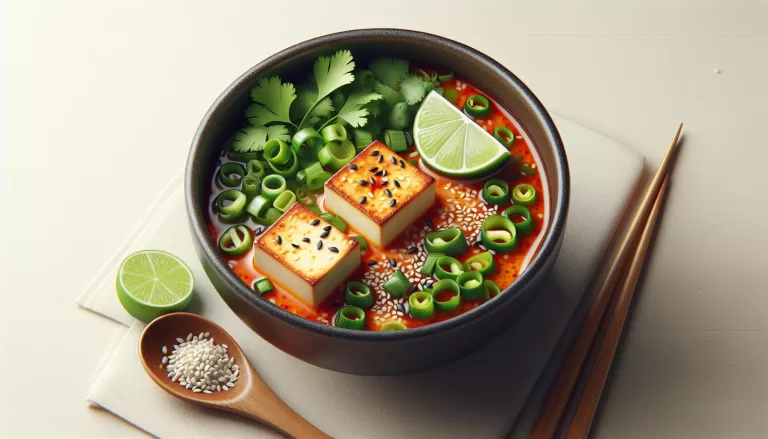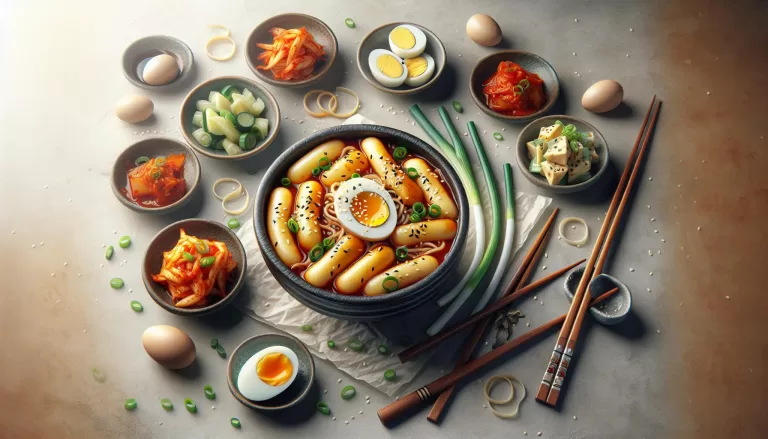Creating Your Unique Ojingeo Bokkeum Spicy Korean Stir Fry at Home

Ingredients for Homemade Ojingeo Bokkeum
Diving into your culinary adventure, it’s essential to assemble all the necessary ingredients first. The magic of Ojingeo Bokkeum lies in the perfect harmony of spices, veggies, and seafood.
Start with buying fresh squid. A medium-sized squid, around 500 grams, will suffice for a family meal. Clean it well and cut it into ring-sized pieces.
A successful Ojingeo Bokkeum recipe also relies heavily on Korean red chili paste, Gochujang, and chili flakes, Gochugaru. Both are integral to achieving that bold, fiery flavor. You’ll need two tablespoons of each.
Don’t forget, the vibrant veggies. Gather one onion, one carrot, and spring onions. Slice the onion and carrot into thin, even pieces. For the spring onions, chop them roughly.
The seasoning will need a tablespoon of sugar, half a tablespoon of soy sauce, a clove of minced garlic, and a teaspoon of ginger.
For an extra kick, consider adding a drizzle of sesame oil and a sprinkling of sesame seeds. They’re not typically included in all recipes, but they underscore the dish’s rich, nutty undertones.
Let’s jump into the nutritional overview.
| Ingredient | Calories | Carbs | Protein | Fat |
|---|---|---|---|---|
| Squid | 198 | 7g | 32g | 3g |
| Gochujang | 60 | 10g | 2g | 1g |
| Gochugaru | 18 | 3g | 1g | 1g |
| Vegetables | 60-80 | 13-17g | 2-3g | 0g |
| Seasoning | 15-25 | 3-5g | 0g | 0g |
With these ingredients in place, you’re already one step closer to your homemade Ojingeo Bokkeum.
Step-by-Step Instructions

To stir up your very own delicious batch of Ojingeo Bokkeum, let’s guide you through it. As a head-start, prepare all your ingredients in advance, also known as mise en place.
Step 1: Preparing the Squid
Clean your fresh squid thoroughly. Ensure you’ve removed the internal parts and ink sac. Cut it into thin, bite-sized pieces, and set it aside.
Step 2: Mixing the Sauce
In a bowl, combine 2 tablespoons of Korean red chili paste, 1 tablespoon of chili flakes, 1 tablespoon of soy sauce, 1 tablespoon of sugar, 2 minced garlic cloves, and a dash of ginger. Mix until smooth. This mix is what will bring the fiery zest to your dish.
Step 3: Stir-Frying the Veggies
In a heated pan, drizzle 1 tablespoon of sesame oil. Add in your vibrant mix of vegetables like bell peppers, onions, and carrots. Stir-fry them until they are just tender yet still crisp.
Step 4: Adding the Squid and Sauce
Add your prepped squid to the pan. Stir fry until it turns slightly translucent. Pour over your previously prepared spicy sauce, making sure everything gets well-coated. Stir fry it all for a few more minutes.
Step 5: Garnishing
Sprinkle 1 teaspoon of sesame seeds on top just before serving. It’s the perfectionist’s touch that adds to the wholesome taste.
For those health-conscious readers, you might be wondering about its nutritional outline. A plateful of Ojingeo Bokkeum would mainly contain calories: 400, carbs: 40g, protein: 20g, fat: 15g.
While the process may seem challenging at first, with practice, you’ll find the balance between the ingredients and synchronize your timing to optimize the flavors. The styles and additions to your Homemade Ojingeo Bokkeum can be as diverse as your imagination. Remember, recipes are just a guideline, not the rule. Feel free to get creative and make it your own. Covet your kitchen with the delicious aroma of your own Homemade Ojingeo Bokkeum.
Tips for Making the Perfect Ojingeo Bokkeum

Among the factors that’ll decide how your Ojingeo Bokkeum turns out, the choices in ingredients will be key. Ingredients and their specific amounts can make or break your dish. So follow the quantities strictly. For instance, if a recipe says 200g of squid, stick to it.
On the other hand, add a personal touch with unique ingredients. How about trying out thinly sliced lotus roots as a garnish? They add a delightful crunch, besides making the dish visually appealing! But remember, while creativity is good in cooking, too many additions can clutter the taste. So, don’t stray too far from the original.
Quality of ingredients is as crucial as the amount used. Worth noting is that fresh ingredients usually give amazing outcomes. Opt for fresh squid over the frozen ones. You’ll appreciate the difference in taste.
Stir-frying is a quick cooking method that needs constant tossing. This can be tricky for beginners. But don’t worry! Practice and patience will get you there. Ensure you have all ingredients handy to prevent burning the dish. Also, maintaining the right heat can enhance the flavors. A medium heat throughout the process is suggested.
Considering the nutritional aspect? Here’s a quick glance!
| Nutrient | Amount per Serving |
|---|---|
| Calories | 346 Kcal |
| Carbs | 26 gram |
| Protein | 24 gram |
| Fat | 15 gram |
The impacting factors of a food’s nutritional value include its ingredients, cooking methods, and portion size. As you become adept at stir-frying and balancing flavors, you can adjust the recipe to suit your diet. Remember, personalizing the food you make is not just about experimenting with flavors but also about adjusting the nutritional profile to serve your needs.
Serving and Presentation Suggestions

Once you’ve gotten the hang of preparing your Ojingeo Bokkeum, you’ll want to know how best to serve and present it. After all, a dish’s visual appeal can be just as important as its taste. Presentation often acts like unwrapping a gift, building anticipation before the first bite.
First off, always serve your stir-fry fresh and hot. Since we’re dealing with seafood, temperature matters. Warmth enhances the natural flavor of the squid and blend of ingredients.
Secondly, think about your choice of dishware. Traditional Korean dishes often look best in earthy, neutral tones. So, opt for stone or ceramic tableware in brown, beige, or deep green hues. It will highlight the vibrant colors of your Ojingeo Bokkeum, turning your meal into a feast for the eyes.
Here’s a hint for plating: place your Ojingeo Bokkeum in the center of the plate. Arrange the squid pieces and vegetables in a pattern if you’d like. Just remember not to over-arrange as it might feel unnatural. Using your culinary intuition is key here!
Don’t forget to garnish. A sprinkle of chopped scallions adds contrast and boosts the vibrant hue of the stir-fry. Sesame seeds impart a subtle crunch and additional flavor layer. A wedge of lemon on the side is also a great idea. It gives your guests the option to squeeze some on, adding an unexpected but delightful tang.
When it comes to sides, Ojingeo Bokkeum pairs deliciously with steamed white rice. It creates a contrast that allows the strong flavors of the stir-fry to shine. Kimchi is also a Korean staple that compliments this dish well.
Pairing your Ojingeo Bokkeum with a refreshing drink helps balance the meal. Green tea or a chilled beer could be excellent choices.
Remember that enhancing this dish’s experience goes beyond taste. It’s a delight for all the senses. Listen to the sizzle, see the vibrant colors, smell the enticing aroma, savor every bite. In the end, it’s about much more than following a recipe. It’s creating and sharing a meal as a token of love and respect for your dear ones. Just keep practicing, stay open to learning and most importantly, enjoy the process.
Variations to Try

Creating an exquisite plate of Ojingeo Bokkeum becomes a more personalized endeavor when adding your unique twist. Be ready to discover and experience, as the potential variations of this Korean gem are as endless as your culinary creativity.
Do you fancy your dish a bit spicier? If the standard Gochujang gives you the heat but not the punch, swap it with the smoky, powerful Chipotle pepper purée. Chipotle peppers are smokey and tend to have a milder, lingering heat – just enough to note its presence but won’t overwhelm your dish.
For those preferring a less fiery, but aromatic version, try incorporating Herb-infused oils in the recipe. Rosemary, thyme, or basil oils infuse the dish with an unexpected, but delightfully fresh twist. It’s an understated way to introduce new flavor dimensions to your Ojingeo Bokkeum.
Now let’s talk about adding some volume to your dish – vegetables. Traditionally, this recipe calls for onions and carrots. But for a more colorful and flavorful variation, consider swapping or adding other veggies like bell peppers or snow peas. Bright bell peppers add a sweet crunch while snow peas contribute a crisp freshness to the mix.
Aside from veggies, you might want to experiment with different proteins. If squid isn’t your favorite, no worries! This recipe is equally delicious when prepared with shrimp, mussels, or even thinly sliced pork. Don’t hesitate to explore these options.
To transform your dish from heavy to hearty, introduce grains into the mix. Add a touch of Quinoa or Couscous for a wholesome element. Either of these can supplement or even replace the traditional white rice.
Remember, cooking is an expression, a creative release. Don’t be afraid to mix it up and make your own version of Ojingeo Bokkeum. Between variable textures, spiciness levels, and tangles of flavors, this Korean dish is your canvas. So, go ahead, test these variations, and craft yours to perfection with love and artistic freedom.
Conclusion
So, there you have it. You’re now equipped with the knowledge to take your Ojingeo Bokkeum to the next level. Remember, cooking is an art form and your kitchen is your studio. Don’t be afraid to mix things up with Chipotle pepper purée, herb-infused oils, or a selection of vibrant vegetables. Swap out the squid for shrimp or pork. Make it heartier with Quinoa or Couscous. Your homemade Korean spicy stir-fried dish is a canvas waiting for your culinary creativity. So, go on. Get in that kitchen and start creating your Ojingeo Bokkeum masterpiece.





